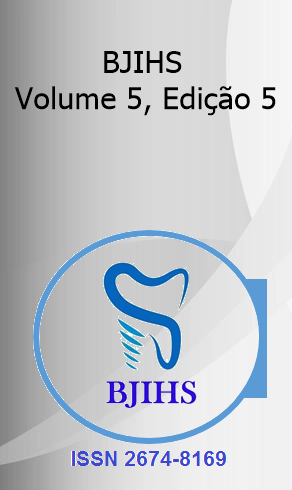Abstract
Stroke (CVA) is a global problem. It can be defined as a neurological deficit caused, abruptly, by the interruption of blood flow to the brain, in an ischemic or hemorrhagic manner. Ischemic stroke represents around 80% of these events, being the most prevalent and incident in Brazil. It is estimated that around 15 million people are affected each year and of these 5 million die. The aggressiveness of this pathology makes it one of the main causes of death in the world, generating high costs, around 0.66% of global GDP. The NIHSS scale, developed in the 1980s, underwent changes in 2004 to improve its usefulness in light of the Brazilian reality and is accepted as a potential modifier of the care offered to post-stroke patients. The objective of this study was to carry out a brief review of the literature on the applicability of the NIHSS scale in post-stroke patients. To prepare this study, databases such as SciELO, MEDLINE/PubMED and LILACS were used. Data analysis showed that, even with the existence of programs to combat the factors that predispose to this pathology, the incidence of this disease may increase in the coming years and the NIHSS scale, although programmed to assist in research, is accepted as an examination more effective clinical approach to quantify the neurological deficit caused by this condition. The scale also proved to be efficient in determining the best treatment by quickly allowing 5 to 8 minutes to understand the patient's current state: regarding the progression of the neurological deficit. An important factor for applying the scale is the training of professionals, which can be carried out online, however, caution must be taken when applying it, as this tool was designed for research purposes.
References
BARBOSA, A. M. de L. et al. Perfil epidemiológico dos pacientes internados por acidente vascular cerebral no nordeste do Brasil. Revista Eletrônica Acervo Saúde, Teresina, v. 13, n. 1, p. e5155, 31 jan. 2021. DOI https://doi.org/10.25248/reas.e5155.2021. Disponível em: <https://acervomais.com.br/index.php/saude/article/view/5155#:~:text=Resultados%3A%20Os%20resultados%20revelaram%20um,74%25%20de%20mortes%20por%20casos> . Acesso em: 21 abr. 2023.
BRASIL. Ministério da Saúde. DATASUS. 2019. Di870, 1989. Disponível em: https://www.ahajour- nals.org/doi/pdf/10.1161/01.STR.20.7.864sponível em . Acesso em 22 maio 2023.
BROTT, T. et al. Measurementsofacute cerebral infarction: a clinicalexaminationscale. Stroke, v.20, n.7, pp. 864-. Acesso em: 20 mai. 2023.
CAMARGO, F. C. et al. Modelos para a implementação da prática baseada em evidências na enfermagem hospitalar: revisão narrativa. Texto & Contexto Enfermagem, vol. 26, núm. 4, 2017, pp. 1-12. Disponível em: <https://www.scielo.br/j/tce/a/w7YdK4vhwv74CgjSv56tFWG/?format=pdf&lang=pt>. acesso em 23 mai. 2023.
FILHO, Geraldo B. Bogliolo - Patologia. Guanabara: Grupo GEN, 2021. E-book. ISBN 9788527738378. Disponível em: https://integrada.minhabiblioteca.com.br/#/books/9788527738378/. Acesso em: 16 ago. 2023.
FEIGIN, V. L et al. World Stroke Organization (WSO): Global Stroke Fact Sheet 2022. International journal of stroke: official journal of the International Stroke Society, v. 17, n.1, p.18-29.2022. Disponível em:https://doi.org/10.1177/17474930211065917. Acesso em 03/08/2023.
HANSEN, John T. Netter Anatomia Clínica. Guanabara: Grupo GEN, 2019. E-book. ISBN 9788535292084. Disponível em: https://integrada.minhabiblioteca.com.br/#/books/9788535292084/. Acesso em: 21 ago. 2023.
LIMA, D. M. N.; OLIVEIRA, G. J.; OLIVEIRA, H. R.; SOUZA, L. A.; HOLANDA, M. M. A.. Uma análise dos custos e internações por acidente vascular cerebral no Nordeste, 2008-2019. Revista Brasileira de Administração Científica, v.12, n.1, p.203-212, 2021. DOI: http://doi.org/10.6008/CBPC2179-684X.2021.001.0016.
LOBO, P. G. G. A. et al. Epidemiologia do acidente vascular cerebral isquêmico no Brasil no ano de 2019, uma análise sob a perspectiva da faixa etária. Brazilian Journal of Health Review, Curitiba, v. 4, n. 1, p. 3498-3505, 14 jan. 2021. DOI 10.34119/bjhrv4n1-272. Disponível em: <https://www.brazilianjournals.com/index.php/BJHR/article/view/25142/20040>. Acesso em: 21 abr. 2023.
Lyden P, Raman R, Liu L, Emr M, Warren M, Marler J. National Institutes of Health Stroke Scale certification is reliable across multiple venues. Stroke. 2009 Jul;40(7):2507-11. doi: 10.1161/STROKEAHA.108.532069. Epub 2009 Jun 11. PMID: 19520998; PMCID: PMC2726278.
LYDEN, Patrick. Using the National Institutes of Health Stroke Scale. 2. ed. Local: American Heart Association, Inc, 2017. 513-519 p. v. 48.
MAMED, S. N. et al. Perfil dos óbitos por acidente vascular cerebral não especificado após investigação de códigos garbage em 60 cidades do Brasil, 2017. Revista Brasileira de Epidemiologia, p. 1-14, 28 ago. 2019. DOI 10.1590/1980-549720190013.supl.3. Disponível em:<https://www.scielo.br/j/rbepid/a/3FNHYXdBVvtCcb9gKZht9KR/?lang=pt#:~:text=Resultados%3A,cr%C3%B4nica%2C%20em%20ambos%20os%20sexos>. Acesso em: 19 mar. 2023.
MINISTÉRIO DA SAÚDE. Manual de rotinas para atenção ao AVC. 2013.
Marsh EB, Lawrence E, Gottesman RF, Llinas RH. The NIH Stroke Scale Has Limited Utility in Accurate Daily Monitoring of Neurologic Status. Neurohospitalist. 2016 Jul;6(3):97-101. doi: 10.1177/1941874415619964. Epub 2015 Dec 13. PMID: 27366291; PMCID: PMC4906553.
PIMENTEL, B. N.; FILHA, V. A. V. dos S.. Evaluation of vestibular and oculomotor functions in individuals with dizziness after stroke. Arq. Neuro-Psiquiatr., São Paulo , v. 77, n. 1, p. 25-32, Jan. 2019 . Available from <http://old.scielo.br/scielo.php?script=sci_arttext&pid=S0004-282X2019000100025&lng=en&nrm=iso>. access on 21 apr. 2023.
SANTOS, J. V. S. dos et al. OS EFEITOS DA CAPACITAÇÃO DE ENFERMEIROS SOBRE AVALIAÇÃO DE PACIENTES COM ACIDENTE VASCULAR CEREBRAL. Rev enferm UFPE on line, Recife, v. 11, n. 5, p. 1763-1768, 1 maio 2017. DOI 10.5205/reuol.11077-98857-1-SM.1105201702. Disponível em: . Acesso em: 29 abr. 2023.
SORIANO, F. F. S.; BARALDI, KA. Escalas de avaliação funcional aplicáveis a pacientes pós acidente vascular encefálico. ConScientiae Saúde, [S. l.], v. 9, n. 3, p. 521-530, 12 jun. 2010. DOI https://doi.org/10.5585/conssaude.v9i3.2227. Disponível em: <https://periodicos.uninove.br/saude/article/view/2227>. Acesso em: 29 abr. 2023.
TELESSAÚDERS-UFRGS. Telecondutas: acidente vascular cerebral. Porto Alegre: TELESSAÚDERS-UFRGS, 2018.
World Health Organization - WHO. Stroke, Cerebrovascular accident. Disponível em: <http://www.who.int/topics/cerebrovascular_accident/en/ 2019> . Acesso em 21 abr. 2023.

This work is licensed under a Creative Commons Attribution 4.0 International License.
Copyright (c) 2023 Diogo Moreira do Amaral, Luciana Fernanandes
